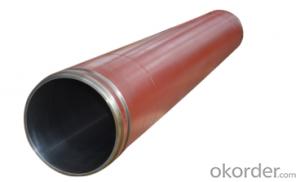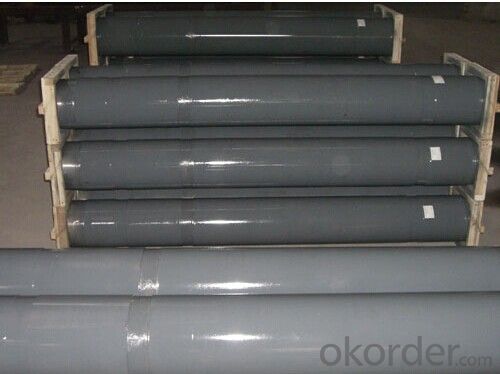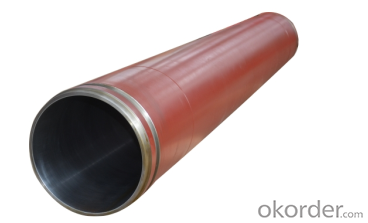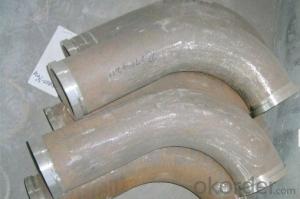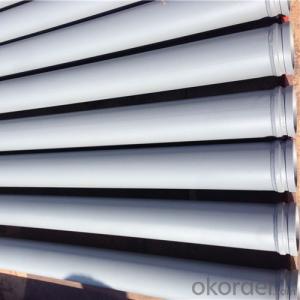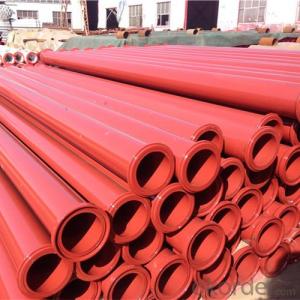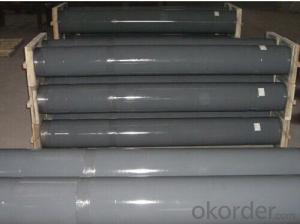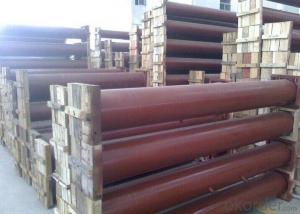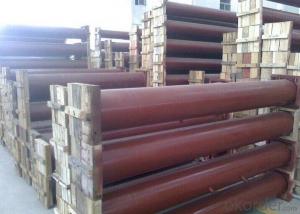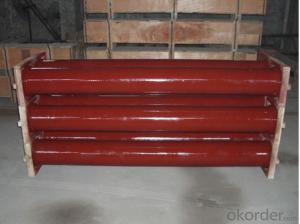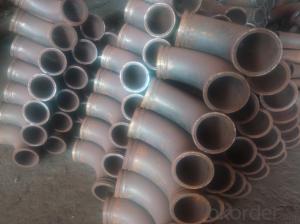PUMPING CYLINDER(PM) I.D.:DN230 CR. THICKNESS :0.25MM-0.3MM LENGTH:2300MM
- Loading Port:
- Shanghai
- Payment Terms:
- TT OR LC
- Min Order Qty:
- 2 pc
- Supply Capability:
- 1000 pc/month
OKorder Service Pledge
OKorder Financial Service
You Might Also Like
Specification Data:
Concrete Pump Delivery Cylinder DN230*2300
1. Capacity: 60,000~80,000cbm
2. Size: DN180, DN200, DN230..
4. Brand: PM, Sany,ZM
Concrete Pump Delivery Cylinder DN230*2300
1. Material: C45
2. quenching and tempering to improve the hardness to HB241-280
3. inner wall chrome thickness is 0.25-0.30mm, hardness HV820-900.
4. Brand: SCHWING, PM, SANY, KYOKUTO, CIFA
5. Capacity: 60,000~80,000cbm
Concrete Cylinder | ||
Material | High Manganese Steel | |
Special | Coating hardness layer in the internalwall | |
Application | In concrete pump trucks | |
For Brand | Sany,Putzmeister,Schwing,,Zoomlion,CIFA etc | |
Details information | ||
Brand | Model | |
219 - DN180*1775-1600 | ||
Schwing | BP3000 | 219 - DN200*1775-1600 |
254 - DN230*2125-1800 | ||
DN230*2300mm | ||
DN230*2100mm | ||
Putzmeister | DN230*1600mm | |
DN200*1600mm | ||
DN180*2000mm | ||
40C1410 | 206-DN180*1530-1400 | |
50C1410 | 210- DN180*1545-1400 | |
60A1406 | 219- DN195*1570-1400 | |
Sany | 60C1416 | 226- DN195*1570-1400 |
60C1816 | 232- DN200*1946-1800 | |
C120/37A | 232- DN200*2162-2000 | |
C120/48 | 262- DN230*2146-2000 | |
62EA | 203-DN 180*1605-1400 | |
62G | 219-DN200*1187-1000 | |
62D | 219-DN200*1587-1400 | |
Zoomlion | 62H | 219-DN200*1787-1600 |
62CA | 219-DN200*1862-1600 | |
62M | 219-DN200*2022-1800 | |
0019931A | 219-DN200*2022-1800 | |
62L | 245-DN205*2284-2000 | |
FAQ:
Q1: How long about delivery time about DN230*2300 ?
A1: Normally we keep the raw materials for old customers and sometime we also keep stock products to make sure delivery time in any emergency cases.
Q2: How do we guarantee the quality of our Concrete Pump Delivery Cylinder DN230*2300 ?
A2: We have established an advanced quality management system which conducts strict quality tests at every step, from raw materials to the final product. At the same time, we provide extensive follow-up service assurances as required.
Q3: How soon can we receive the product after purchase?
A3: Within three days of placing an order, we will book the vessel for goods. The specific shipping date is dependent upon international and government factors, but is typically 7 to 30 workdays.
Q4: If we can produce some Concrete Pump Delivery Cylinder DN230*2300 according to customers request?
A4: Yes, we can produce Concrete Placing Boom according to the difference country situations to make it suitable to the market and customers. We have very professional technical team to make the design.
Q5: How to make a quick resolution for after service?
A5: OKorder and our manufacture both have overseas branches all-around of world, IF needed,
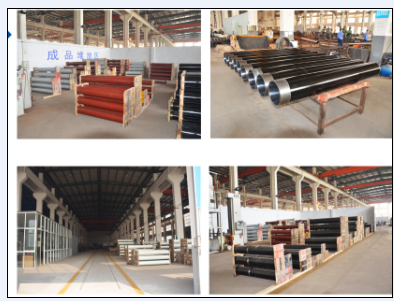

- Q: How do I properly maintain and replace hydraulic cylinders in concrete pump spare parts?
- Proper maintenance and replacement of hydraulic cylinders in concrete pump spare parts requires a systematic approach. Firstly, regular inspections should be conducted to identify any signs of wear, leakage, or damage. It is important to clean the cylinders regularly to remove any debris or contaminants that can cause premature failure. To maintain the hydraulic cylinders, it is crucial to follow the manufacturer's recommendations for lubrication and fluid changes. Ensure that the hydraulic fluid levels are checked and maintained within the specified range. Additionally, monitor the pressure and temperature of the system to detect any abnormal conditions that may indicate a problem with the cylinders. When it comes to replacement, it is essential to use genuine and high-quality hydraulic cylinders that meet the specifications of the concrete pump. Consult the manufacturer's guidelines for the correct procedure for removing and installing the cylinders. Proper alignment and adjustment of the cylinders are crucial to ensure their optimal performance and longevity. In summary, proper maintenance involves regular inspections, cleaning, lubrication, and monitoring of the hydraulic system. Replacement should be done with genuine parts and following the manufacturer's guidelines. By following these steps, you can ensure the reliable and efficient operation of hydraulic cylinders in concrete pump spare parts.
- Q: Are there any specific guidelines for the installation of wear plates or wear rings in concrete pump spare parts?
- Yes, there are specific guidelines for the installation of wear plates or wear rings in concrete pump spare parts. These guidelines typically include ensuring proper alignment and fit, using the correct torque specifications for fasteners, and applying appropriate lubrication. It is important to follow these guidelines to ensure optimal performance and longevity of the wear parts.
- Q: What are the different types of concrete pump hopper vibrators?
- There are two main types of concrete pump hopper vibrators: electric and pneumatic. Electric vibrators are powered by electricity and use an electric motor to generate vibrations. They are typically more powerful and efficient but require a power source. Pneumatic vibrators, on the other hand, are powered by compressed air and use air pressure to create vibrations. They are portable and do not require a power source, making them more suitable for remote or inaccessible areas.
- Q: How often should concrete pump accumulators be inspected and replaced?
- Concrete pump accumulators should be inspected at least once a year to ensure their proper functioning and identify any potential issues. However, the frequency of replacement depends on various factors such as usage, maintenance, and the manufacturer's recommendations. It is recommended to consult the equipment manual or contact the manufacturer for specific guidelines on replacement intervals.
- Q: How can a malfunctioning hydraulic motor affect the pumping process?
- A malfunctioning hydraulic motor can significantly affect the pumping process in several ways. Firstly, it may not be able to generate enough power or torque to drive the pump effectively, resulting in reduced pumping capacity or even complete failure. Secondly, the malfunctioning motor can cause irregular or inconsistent fluid flow, leading to an inefficient pumping process and decreased overall performance. Additionally, it can result in excessive heat generation, which may cause damage to the motor and other components of the hydraulic system. Overall, a malfunctioning hydraulic motor can disrupt the pumping process, leading to decreased efficiency, reduced output, and potential system damage.
- Q: How long does it take to receive concrete pump spare parts after ordering?
- The time it takes to receive concrete pump spare parts after ordering can vary depending on several factors. It is important to note that the availability of the specific spare parts you need and the location of the supplier can significantly impact the delivery time. In general, if the spare parts are readily available and in stock, you can expect to receive them within a few days to a week. This assumes that the supplier has a streamlined order processing system and prompt shipping arrangements. However, if the spare parts are not in stock, it may take longer to receive them. In such cases, the supplier may need to order the parts from a manufacturer or source them from a distributor. This could add additional lead time to the delivery process, ranging from a few weeks to several months, depending on the availability and sourcing process. It is advisable to check with the supplier or manufacturer before placing the order to get an estimate of the delivery time. Factors like the supplier's location, transportation mode, and any potential customs or logistics delays should also be taken into consideration. To expedite the delivery process, some suppliers may offer expedited shipping options at an additional cost. This can be beneficial if you need the spare parts urgently. Overall, the time it takes to receive concrete pump spare parts after ordering can vary, but being proactive, communicating with the supplier, and planning ahead can help ensure a smoother and quicker delivery process.
- Q: How much is the pump for a month?
- In the mud, the price is about 25 yuan per square, according to my experience, more than 175000 points per month can pump 7000 yuan, totaling $
- Q: How can a faulty accumulator affect the pumping efficiency?
- A faulty accumulator can negatively impact pumping efficiency by causing inconsistent pressure and flow rates in the system. This can lead to excessive energy consumption, reduced overall performance, and potential damage to the pump and other components.
- Q: How do I properly maintain and replace hydraulic pumps in concrete pump spare parts?
- Properly maintaining and replacing hydraulic pumps in concrete pump spare parts is crucial to ensure the smooth functioning and longevity of the equipment. Here are some steps to help you in this process: 1. Regular Inspections: Perform frequent visual inspections of the hydraulic pump to identify any signs of wear, leaks, or damage. Check for loose bolts, damaged seals, or excessive noise during operation. These inspections should be done before and after each use. 2. Follow Manufacturer's Guidelines: Refer to the manufacturer's guidelines and recommendations for maintenance and replacement of hydraulic pumps. They will provide specific instructions on the frequency of maintenance, lubrication, and replacement intervals. 3. Lubrication: Proper lubrication is essential for the smooth operation of hydraulic pumps. Check the oil levels regularly and top up if necessary. Use the recommended oil or hydraulic fluid as specified by the manufacturer. Follow the guidelines for the frequency of oil changes. 4. Regular Cleaning: Keep the hydraulic pump and its components clean from debris, dust, and dirt. Use a clean cloth or compressed air to remove any contaminants that may have accumulated. This will help prevent damage and reduce the risk of clogs or blockages. 5. Replace Worn Parts: Over time, certain components of the hydraulic pump may wear out and require replacement. Keep a stock of spare parts, including seals, gaskets, and filters, to be able to promptly replace any worn or damaged components. 6. Seek Professional Assistance: If you are unsure about any aspect of maintaining or replacing hydraulic pumps, it is always advisable to seek the assistance of a professional technician or the manufacturer. They have the expertise and knowledge to guide you through the process and ensure the best possible maintenance and replacement practices. Remember, regular maintenance and timely replacement of hydraulic pumps in concrete pump spare parts will not only extend the lifespan of the equipment but also ensure safe and efficient operation on construction sites.
- Q: Can concrete pump spare parts be purchased online?
- Indeed, online purchases of concrete pump spare parts are possible. Numerous online platforms and websites cater specifically to the sale of construction equipment and spare parts, including those for concrete pumps. These digital stores present a comprehensive assortment of options and brands, enabling customers to peruse and choose the precise spare parts required for their concrete pump. Moreover, online buying grants the convenience of price comparison, perusal of customer reviews, and doorstep delivery of the spare parts. Nevertheless, it remains imperative to ascertain the authenticity and dependability of the online store prior to making a purchase, guaranteeing the acquisition of genuine and top-notch spare parts.
Send your message to us
PUMPING CYLINDER(PM) I.D.:DN230 CR. THICKNESS :0.25MM-0.3MM LENGTH:2300MM
- Loading Port:
- Shanghai
- Payment Terms:
- TT OR LC
- Min Order Qty:
- 2 pc
- Supply Capability:
- 1000 pc/month
OKorder Service Pledge
OKorder Financial Service
Similar products
Hot products
Hot Searches
Related keywords



